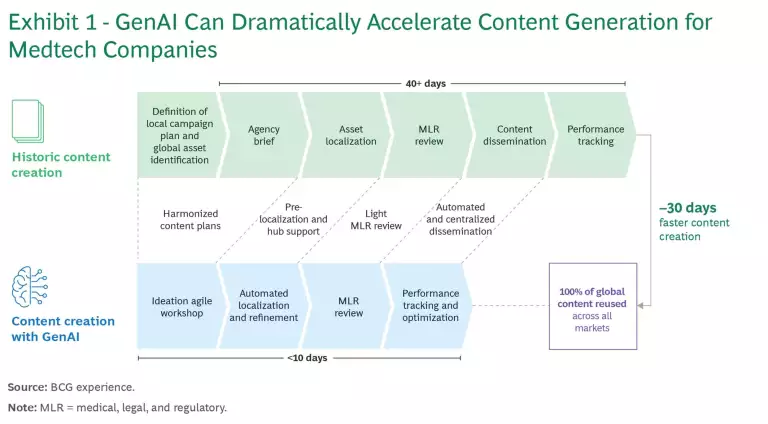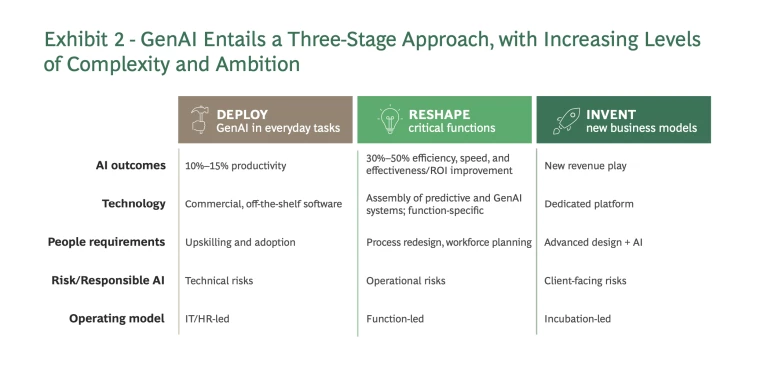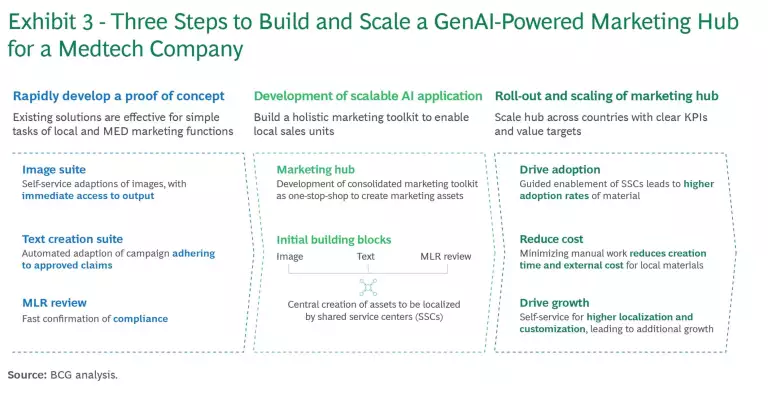In the business world’s sprint to reap benefits from generative AI (GenAI), most medtech companies are still in the earlier stages of implementing the technology. A BCG study found that while 24% of companies across sectors have created value from GenAI, only 10% of medtech companies have achieved this, with the remaining 90% seeing limited or no measurable impact.
One area where medtech companies are starting to make progress is in the marketing function. Leading organizations are already using GenAI to quickly produce engaging text and imagery, generate new ideas, enable hyper-personalized messaging, automate repetitive tasks, ensure consistency, and provide deep data insights. In that way, they are dramatically improving their marketing performance even as they reduce marketing spend. In our client work we have seen gross cost savings of up to 60% to 80% on text assets and a four-fold increase in the speed of asset generation.
To capitalize on this potential, medtech companies need to scale up from pilots to broader, end-to-end implementation across the marketing function, coupled with strong change management programs to ensure that managers and employees fully embrace the technology. They also need to integrate responsible AI and governance to ensure that GenAI-created content complies with medical, legal, and regulatory (MLR) reviews.
GenAI Offers Multiple, Tangible Benefits in Medtech Marketing
GenAI-enabled tools can deliver a range of benefits for medtech marketing functions, foreshadowing a new approach in which marketers focus less on repetitive tasks and more on strategic and conceptual work. For years, many marketers have looked to make marketing production more efficient. They have also sought to meet the long-unfulfilled promise of hyper-personalization in messaging prospects and customers—leading to greater effectiveness through higher conversion rates, more valuable client interactions, and better prioritization of value-accretive activities.
In our experience, GenAI can reduce the timeline to create a marketing campaign from months to weeks or even days. (See Exhibit 1.) Given the speed, low cost, and quality of content generation, GenAI opens up new approaches to marketing. For instance, always-on campaigns can be powered by GenAI to run marketing efforts continuously while adapting to customers at all stages of their journey.

These gains in efficiency track with other proof points emerging across industries, where companies have already successfully scaled use cases in marketing and other commercial areas. For example, Klarna, a Swedish payments processor, announced a 25% external spend reduction on marketing after utilizing GenAI. Similarly, Reckitt, a health and personal care company, announced a 60% reduction in concept development and 90% in post-campaign media analysis.
Three Phases of Maturity in GenAI Use
Implementing GenAI in marketing entails a three-part approach, with increasing levels of ambition and complexity. (See Exhibit 2.)

Deploy.
We think of the deploy phase as one in which clients leverage off-the-shelf tools or existing GenAI-embedded tools to perform simple marketing function tasks via point solutions. This could come in the form of an AI-generated campaign brief, which leverages consumer insights, or multi-variate headline and description copy for search advertising. Some ad platforms and software companies have added many GenAI features into their existing offering and workflows over the past year, substantially lowering the barriers to adoption for GenAI in marketing. These are often a great starting point for companies to start applying GenAI to make individual tasks and process steps more efficient, generating efficiency gains of 10% to 15%.
Implementing GenAI tools typically requires updates to a company’s existing software procurement approach with respect to responsible AI checks and training for affected employees. However, in most instances, companies can begin applying the technology with limited GenAI expertise, helping them quickly realize value and build momentum in the organization.
Reshape.
The reshape phase involves transforming a process from end-to-end, moving beyond point solutions and reimagining a task through GenAI-enabled ways of working. To achieve greater impact, medtech companies need to fundamentally adapt processes and transform the marketing function, leading to improvements of 30% to 50% in efficiency, speed, and return on marketing spend.
For example, one of the most implemented E2E transformations, which pieces together several point solutions or use cases, is the development of creative assets, such as social media posts or targeted invitations and emails to health care professionals. This process begins with insights generation and brief development, which then informs text, image, audio, and video asset generation. This output then undergoes MLR/compliance review via a GenAI co-pilot or review tool. Finally, the output is deployed to a platform like Meta, Google, or Salesforce, and the performance in market is relayed back to a client’s GenAI platform to learn from those metrics in the regeneration of new assets.
Most GenAI solutions now include an advanced capability to generate high-quality imagery, with video on the horizon, and we expect these solutions to improve rapidly. Given such expanding capabilities, it is important that companies build up their GenAI implementation skills now to benefit from even more advanced tools later. Critically, this stage is where companies must carefully integrate an MLR process with marketing processes, given the level of regulation around medical products. Outside of medtech, Pfizer is a good example—the company launched its own GenAI marketing platform, putting it at the forefront of the industry.
GenAI marketing initiatives today are primarily concentrated in the first two categories—deploy and reshape.
Invent.
The third level of maturity and ambition—invent—entails developing entirely new revenue sources or customer experiences. Although we have seen first examples of new customer experiences in the consumer segments, such as the Beauty Genius Guide by L’Oréal, implementation in medtech is more challenging given the high level of regulation, making it a longer-term option for most companies.
Stay ahead with BCG insights on the health care industry
We assisted a medtech company in developing a GenAI patient management solution, leveraging proprietary knowledge about its products and procedures to answer patient inquiries. This tool was needed because the company’s customers were overwhelmed with a high volume of patient interactions but had limited resources due to staff shortages in the healthcare industry. For this system, having a human in the loop was essential to eliminate the risk of sending out the small share of unsuitable answers that were created by GenAI. Initial pilots indicate a reliable performance, with 93% of responses meeting patient-ready standards.
Customer Example: Reshaping the Marketing Function for a Medtech Company
We have completed several projects with leading medtech companies to reshape their marketing function—in particular, new asset generation and content strategy. In one example, a company wanted to reduce external spend and make its marketing communications more relevant by reducing the time to launch and adapting centrally developed marketing assets, including text and images, to local needs. The project consisted of three phases. (See Exhibit 3.)

Phase 1: Develop a value proof based on three initial applications.
To start, the company developed three GenAI applications: text generation (through a large language model), an image suite (through diffusion), and an MLR review for compliance. The text and image models generate marketing and promotional materials, and the MLR component is a separate, standalone review model that evaluates these materials for compliance. This segregated approach is critical in that it creates a second-order review—rather than a single model that generates and checks the material (which would increase the risk of noncompliance).
Phase 2: Scale the applications.
To scale the GenAI offering, the company combined all three applications into a marketing suite and integrated it into the company’s tech stack of existing marketing software. In this phase, it’s essential to control inference cost—the cost of using a trained AI model to generate assets based on new data or prompts. Inference costs can be significant and erode, or even eliminate, the projected cost savings.
Phase 3: Roll out to local markets.
After creating the tech setup, the company is now preparing for a full roll-out of the model to local markets. In this phase, companies often underestimate the amount of change management and continuous monitoring required. While GenAI is a powerful technology, it will not succeed unless employees adopt it and change their behavior accordingly. In addition, the company is building mechanisms to closely track and manage the cost savings.
The initial pilot results indicated a potential reduction of 60% to 80% gross savings on text assets and a four-fold increase in the speed of asset generation. Those efficiency gains and cost reductions are in line with the savings that GenAI-enabled marketing has created for companies in other industries.
The Agenda for Marketing Leaders
Given these early successes, there is no rationale for a “wait-and-see” approach among medtech marketing leaders. To get started, we believe companies should focus on the following concrete steps.
- Prioritize a manageable number of validated marketing use cases with clear potential to improve top-line or cost for scaling—not just experimentation—and generate enthusiasm among employees for GenAI to shape a positive narrative.
- Build a clear business case for implementation and track performance. Many companies do not have a quantified perspective on the potential value from GenAI in marketing, and those that do often fail to set predefined KPIs and rigorously track them to gauge the P&L impact at scale.
- Get the organization ready for GenAI-enabled transformation, including bedrock principles of responsible AI and the right operating model. Some companies create a GenAI playbook that lays out best practices regardless of tool access, awareness, skills, support, tracking, and responsible AI.
- Institutionalize a strong linkage between tech and marketing functions, with clear responsibilities and incentives.
- In addition to demonstrating short-term value with reshape and deploy GenAI applications, start developing longer-term, differentiated GenAI products and customer experiences—invent—that lead to new revenue.
Don’t overlook the change management component. We often observe that there is too much focus on the tech aspects of GenAI, but process and people elements need careful attention and a sufficient commitment of time and other resources. BCG research has found that the companies that succeed with GenAI follow the 10-20-70 rule: 10% of the effort goes into building AI models, 20% goes to making the right data available, and the remaining 70% focuses on changing processes, including day-to-day behaviors among employees.
In the future, medtech companies may be able to integrate GenAI into new patient-facing products and services. That day is not here yet. But there are clear applications for the technology—particularly in marketing. In our work with companies in medtech, biopharma, and other healthcare segments, GenAI enables faster time-to-market, more efficient marketing processes, greater personalization, and stronger MLR compliance—all of which can have a meaningful impact on the bottom line.
There is no advantage in waiting and a clear upside for the medtech companies willing to be bold in how they use GenAI to revamp marketing.
The authors would like to thank Alan Grimm, Sören Grothkopp, Nikolaus Zeiss, Meghna Eichelberger, and Mitch Krogman for their contributions to this publication.






